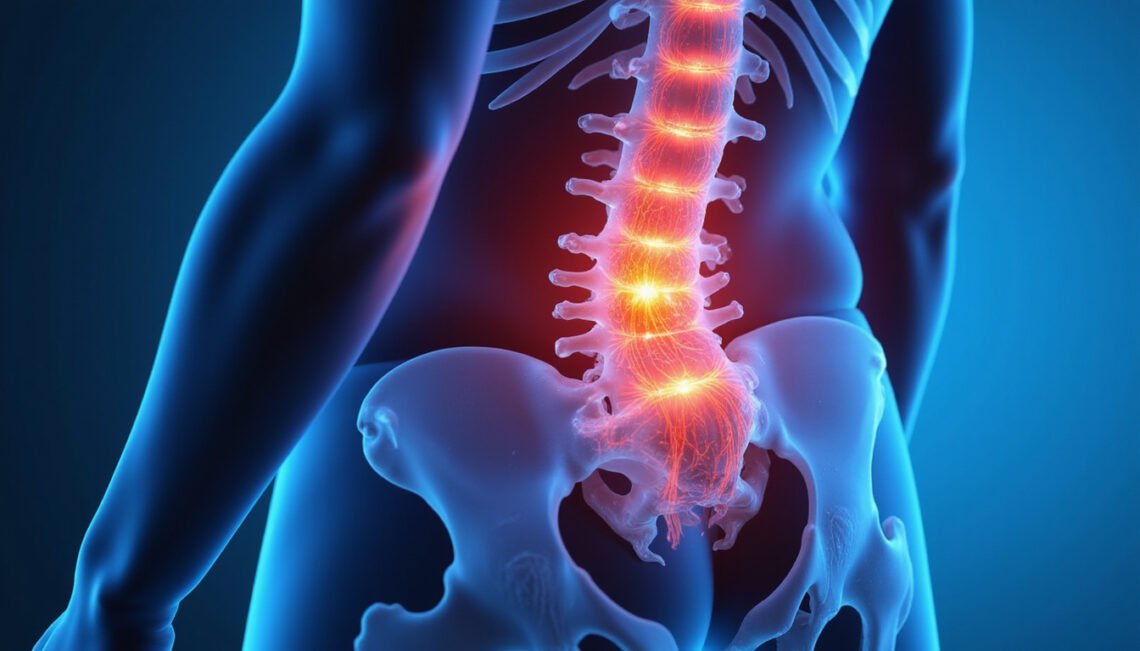Lumbar radiculitis is a condition that affects the lower part of the spine, causing pain, numbness, and tingling sensations along the nerve pathways in the legs. This disorder occurs when the nerve roots in the lumbar spine become inflamed or compressed, leading to neurological symptoms that can disrupt daily life. Understanding lumbar radiculitis is crucial for early diagnosis and effective management of symptoms. In this article, we will explore the symptoms, causes, and effective treatment options available for lumbar radiculitis to help those affected regain mobility and comfort.
What is Lumbar Radiculitis?
Lumbar radiculitis refers to inflammation of one or more nerve roots in the lumbar part of the spine, which is located in the lower back. This inflammation typically causes pain that radiates from the lower back down through the legs, a condition sometimes also called sciatica when it involves the sciatic nerve. The inflammation can result from various underlying issues, such as herniated discs, spinal stenosis, or bone spurs compressing the nerves.
Common Symptoms of Lumbar Radiculitis
Recognizing the symptoms of lumbar radiculitis early is important for seeking timely treatment. Common symptoms include:
- Lower back pain: Often sharp or burning, located near the affected nerve roots.
- Radiating leg pain: Pain may travel down the buttocks, thighs, calves, and feet.
- Numbness or tingling: A pins-and-needles sensation can appear in the affected leg or foot.
- Muscle weakness: Difficulty moving the leg or foot due to nerve impairment.
- Loss of reflexes: Reflexes in the knees or ankles may diminish depending on which nerve is affected.
Symptoms usually worsen with certain movements like bending, twisting, or prolonged sitting and may improve when lying down.
Causes of Lumbar Radiculitis
Several factors can contribute to the development of lumbar radiculitis, primarily those that lead to nerve root irritation or compression. The most common causes include:
- Herniated or slipped discs: When the soft inner material of a spinal disc pushes through its outer layer, it can press on nearby nerve roots.
- Spinal stenosis: Narrowing of the spinal canal or nerve root canals compresses the nerves.
- Bone spurs (osteophytes): Extra bone growths from arthritis can reduce space for nerves.
- Degenerative disc disease: Age-related wear and tear causes discs to lose height and cushioning ability, leading to nerve irritation.
- Injuries: Trauma to the lower back from falls or accidents can cause nerve inflammation.
- Infections or tumors: Although rare, these can also affect lumbar nerve roots.
Diagnosing Lumbar Radiculitis
A medical professional will perform a detailed clinical evaluation, focusing on a history of symptoms and physical examination. Common diagnostic steps include:
- Neurological exam: Checks strength, sensation, and reflexes.
- Imaging tests: MRI scans are the preferred method as they provide clear pictures of the discs, nerves, and spinal canal. X-rays and CT scans may also be used to evaluate bone structures.
- Electrodiagnostic tests: Such as electromyography (EMG), which assess nerve function.
Early and accurate diagnosis is key to developing an appropriate treatment plan.
Effective Treatment Options for Lumbar Radiculitis
Treatment of lumbar radiculitis depends on the severity of symptoms and the underlying cause. Many cases respond well to conservative (non-surgical) therapies, while others may require more invasive procedures.
Conservative Treatments
Most patients start with conservative management, including:
- Medications:
- Nonsteroidal anti-inflammatory drugs (NSAIDs) to reduce pain and inflammation.
- Oral steroids or epidural steroid injections to decrease nerve root inflammation.
- Muscle relaxants and neuropathic pain medications as needed.
- Physical therapy:
- Customized exercises to strengthen back and core muscles.
- Stretching routines to improve flexibility and decrease nerve pressure.
- Posture training to avoid further injury.
- Activity modification:
- Avoiding activities and positions that exacerbate symptoms.
- Using ergonomic furniture and supportive mattresses.
- Heat and cold therapy: Helps reduce muscle spasm and inflammation.
Surgical Treatment
Surgery may be considered if symptoms are severe, persistent, or accompanied by significant neurological deficits such as muscle weakness or bladder control issues. Surgical options include:
- Microdiscectomy: Removal of herniated disc material pressing on the nerve.
- Laminectomy: Removal of part of the vertebra (lamina) to relieve nerve compression.
- Spinal fusion: In cases of instability or severe degeneration.
Patients generally recover well from surgery, especially when combined with postoperative rehabilitation.
Lifestyle and Home Remedies for Managing Lumbar Radiculitis
In addition to medical treatment, lifestyle changes can greatly contribute to managing lumbar radiculitis symptoms:
- Regular low-impact exercises: Swimming, walking, or cycling help maintain spine health.
- Maintaining healthy weight: Reduces pressure on the lumbar spine.
- Ergonomic workspaces: Proper chair and desk setups prevent strain.
- Proper lifting techniques: Use legs instead of back to lift heavy objects.
- Smoking cessation: Smoking impairs disc and nerve root healing.
In addition to medical treatment, lifestyle changes can greatly contribute to managing lumbar radiculitis symptoms:

Frequently Asked Questions About Lumbar Radiculitis
1. How is lumbar radiculitis different from sciatica?
Lumbar radiculitis specifically refers to inflammation of the lumbar nerve roots, which may cause sciatic nerve pain symptoms. Sciatica is a broader term describing pain radiating along the sciatic nerve’s pathway. Therefore, lumbar radiculitis can cause sciatica, but not all sciatica is due to radiculitis.
2. Can lumbar radiculitis heal on its own?
Mild cases of lumbar radiculitis may improve with rest, physical therapy, and medications over several weeks. However, persistent or severe symptoms require professional evaluation to prevent long-term nerve damage.
3. What exercises are safe for lumbar radiculitis?
Gentle stretching, pelvic tilts, and core strengthening exercises designed by a physical therapist are usually safe and beneficial. High-impact or heavy lifting exercises should be avoided during flare-ups.
Conclusion
Lumbar radiculitis is a common condition that can significantly affect quality of life due to pain and neurological symptoms in the lower back and legs. Understanding the symptoms and causes is essential for prompt diagnosis and management. Fortunately, a variety of effective treatment options exist—ranging from medications and physical therapy to surgical interventions for more severe cases. Incorporating lifestyle changes and working closely with healthcare providers can help manage symptoms and improve outcomes. If you or a loved one are experiencing symptoms consistent with lumbar radiculitis, consult a medical professional promptly to receive an accurate diagnosis and begin an effective treatment plan.
For more detailed information about nerve-related back conditions, you can visit the American Academy of Orthopaedic Surgeons website (source). Take control of your spinal health today by seeking support and exploring the treatment options that can restore your mobility and reduce pain. Don’t let lumbar radiculitis limit your lifestyle—start your recovery journey now.





